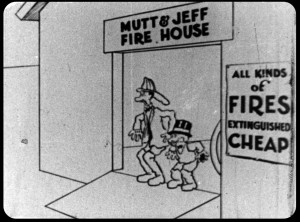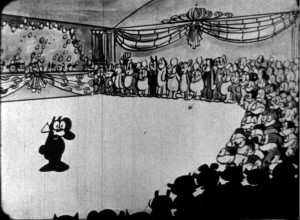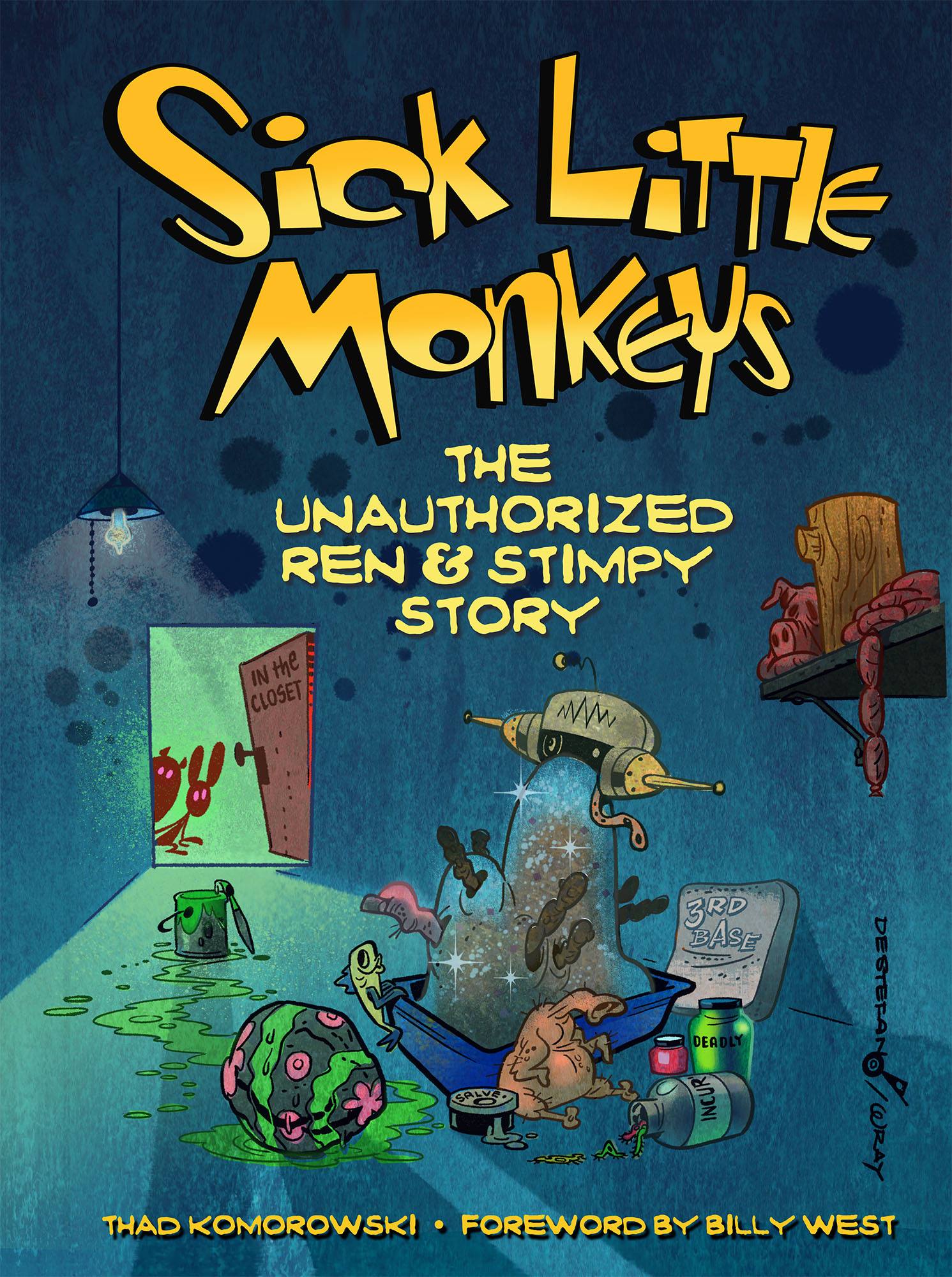Like everyone else in the animatophile community, I spent my Sunday night by not watching the Seth MacFarlane block on FOX, but the block of classic animation on Turner Classic Movies, co-hosted by the patron saint of animation, Jerry Beck. Actually, those shows were cancelled in favor of baseball, so perhaps ratings for TCM got a boost.
Starting the block were the only two animated features of the Golden Age that weren’t made by Disney, the Fleischers’ Gulliver’s Travels and Mr. Bug Goes to Town. The transfer of Gulliver was incredibly weak and muddled with the DVNR process. Along with having its original title reinstated, Mr. Bug looked beautiful. I’m very familiar with the 35mm nitrate from the Museum of Modern Art they used, and it’s delightful that everyone was able to see that genuine, raw 1941 Technicolor for themselves.
If only either of them were truly great films though! What I get from both of the Fleischer movies is an overwhelming sense that the animators just didn’t want to make the damn things. You don’t need to read J.B. Kaufman’s excellent new book on Snow White and the Seven Dwarfs (which I will be reviewing shortly) to know that that film is the product of a man with an obsession, backed by a fleet of artists determined to do their part in realizing it.
The polar opposite is true of Gulliver’s Travels, an almost willfully convoluted film on every level. The Fleischer studio simply tried in vain to be something they weren’t. There are some very elaborate sequences, but they are smothered by overlong stretches of needless exposition and shameless forgeries from Disney’s first picture. It’s said that one possible route early in development was to feature Popeye as Gulliver, and it’s so easy to envision a richer film evolving out of that concept. Sadly they didn’t, and we have the very poor film that launched TCM’s animation celebration.
Perversely, the second Fleischer feature, Mr. Bug Goes to Town, tanked, even though it’s a vast improvement over the studio’s first. The animators had returned to their element. They came up with an original story, making Mr. Bug far grittier and earthier than any of the Disney films. The animation is generally slick and well-acted, calling to mind the better wartime Famous shorts. Unfortunately, the film is terminally flawed when its most engaging characters are the comedic, one-dimensional villains.
Many have made the comparison between Mr. Bug and Frank Capra (beyond the title) and it’s apt. The film certainly plays like one of Capra’s in its depiction of societal/class conflict and forced (but effective) emotion, but only after you’ve ironed out the charisma and maturity of Mr. Deeds Goes to Town and It Happened One Night. A unique kind of character animation flourished at the Fleischers in the 1930s, but it was absent in their films after the move to Miami. The Popeye series got into a clumsy rut and the Superman cartoons are outright embarrassments. It’s only natural any movie made in that environment would suffer accordingly. Shame that another feature wasn’t made with this crew, even under the Famous moniker. They might have gotten it on the third try.
I skipped the UPA block entirely. I think 2012 will be known as “The Year of UPA,” what with Adam Abraham’s book and the Jolly Frolics collection. As a result, there is collective exhaustion of the topic. Unlike the Disney and Warner canons that have dozens of films still commanding attention, UPA’s golden era is miniscule and doesn’t invite the same level and volume of critical analysis (certainly nothing beyond design after John Hubley left). It will be a long time before I ever willingly watch one of them again, save Rooty Toot Toot or the Fox and Crows. But TCM’s selection did include all of the UPA cartoons that are worth going out of your way to see at any rate, and they must be applauded.
Actually, the applause has to go to TCM for featuring films from the archive of my near-lifelong friend Tom Stathes. Like any medium, the works in its gestation period can be endlessly fascinating. The silent animation highlighted from Tom’s collection go beyond mere historical curios: they are genuinely entertaining historical curios. In this age where it’s actually feasible for one person to do a film singlehandedly, I rarely see one iota of the creativity regularly exhibited in this period (in which one guy had to do everything).
A lot of silent animation was certainly mechanical, and often showy to compensate for the lack of good ideas. It’s not an issue when something like the sheer inventive imagery of J. Stuart Blackton’s The Haunted Hotel or Winsor McCay (note the spelling) is commanding the attention; only when characters take the center stage does the lack of cinematic prowess become obvious. But film itself was still developing. It took silent live-action film years to regularly deliver compelling personalities and narratives. Like those early comedies, when the humor worked in these cartoons, it worked.
Koko the Clown is always a favorite, and the more I see of Mutt and Jeff, the more I like those cartoons (the featured Fireman Save My Child delivers an alarmingly high amount of well-executed gags). Sometimes they were a little too good this early in the game. Paul Terry’s Springtime with Farmer Alfalfa is actually better acted and written than most of the cartoons he did with sound. Curiously absent was Otto Messmer’s Felix the Cat, though hopefully that will be remedied ‘next time’. In its place was a delightful Bill Nolan Krazy Kat, Scents and Nonsense, which plays like a better Felix (with more elaborate animation).
I hope that the animation block was a success. A regular line-up is obviously capable of provoking the same kind of historical insight, intelligent commentary, and plain inspiration that TCM’s thoughtful programming has done regularly. A heartfelt thanks to Mssrs. Beck and Stathes (and Steve Stanchfield and David Gerstein) for making it transpire.





Ugh, another UPA rant. We get it, Thad.
Interesting thoughts on the Fleischer features. I have to admit that I have a nostalgic love for them, as I saw them often on TV when I was a kid. However, I am one of the people who wishes that Gulliver had been done with Popeye. Who knows? Maybe Genndy Tartakovsky will correct that error.
The straight leads in the Fleischer features are deadly dull, though. Disney had trouble with straight leads, but he looks like Shakespeare next to the Fleischers. I also think that the Fleischers were handicapped by the lack of voice talent in Florida. While Disney didn’t use big stars, people like Lucille La Verne, Billy Gilbert, Cliff Edwards and Christian Rubb were thorough professionals. As much as I love Jack Mercer, he was over-used in the features. If you eliminate him, Pinto Colvig and Tedd Pierce, there are few, if any, memorable voices in the two films.
Is Tedd Pierce the voice of King Bombo?
I’m not sure who voiced King Bombo. I messaged Keith Scott, who would know for sure. But it seems the casts of the Fleischer features were negatively impacted by the move to Miami. No film industry means no easy access to the talent.
I’d have rather seen Popeye in the leading roll as well (colorful and funny lead characters being almost non-existent in animated features). However, I’m not sure the Gulliver story is a good fit for him. I’d rather they did a proper Popeye story along the lines of the Segar strip. Even if it didn’t work, it probably would have been more interesting than aping Disney.
This marked the very first time I had ever seen “Mr. Bug” in its entirety, and I quite enjoyed it. I agree with Mark that the voice characterizations were limited by the lack of voices available to the Fleischers at the time (and Jack Mercer, talented though he was, was no Mel Blanc). By and large, however, I thought the animation was superb, the music very good, and the story line, though kind of pedestrian, at least held my attention. On the other hand, “Gulliver” — which I hadn’t seen in quite a while — didn’t do much for me. The restored Technicolor print was beautiful, but the story and characters are really weak.
The same can be said for the Superman shorts — waaaay short on character development — but I’ve never quite understood, Thad, why you dislike them as much as you do. I’d hardly say they were an “embarrassment” to the studio. Much of the animation is fast-paced (some of it amazingly so);
some of the the backgrounds are stunning; and the sci-fi/horror plots of the some of the Fleischer episodes are, IMHO, beautifully executed, even if their premises are ridiculous. I’m with Jerry Beck — these are among the best fantasy cartoons ever done.
I found a 16mm film at my grandma\’s closet and (among other amazing family films) it was this short animated cartoon film.
I\’m not sure if it\’s Koko the clown or not. Can you help me? Many thanks!